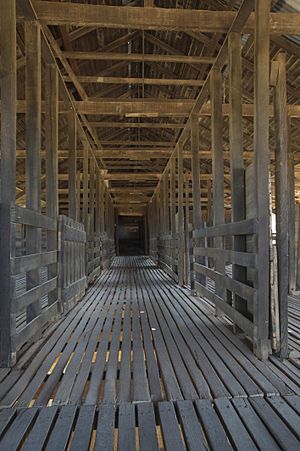Kinchega Woolshed facts for kids
Quick facts for kids Kinchega Woolshed |
|
|---|---|
 |
|
| Location | 15km south-west of, Menindee, Central Darling Shire, New South Wales, Australia |
| Built | 1875–1875 |
| Owner | Office of Environment and Heritage |
| Official name: Kinchega Woolshed | |
| Type | state heritage (built) |
| Designated | 2 April 1999 |
| Reference no. | 995 |
| Type | Woolshed/Shearing Shed |
| Category | Farming and Grazing |
| Lua error in Module:Location_map at line 420: attempt to index field 'wikibase' (a nil value). | |
Kinchega Woolshed is a really old and important building in New South Wales, Australia. It's a heritage-listed former shearing shed, which is a large building where sheep are shorn for their wool. This amazing structure was built in 1875.
You can find Kinchega Woolshed about 15 kilometers (9 miles) southwest of the town of Menindee. Today, the New South Wales Office of Environment and Heritage looks after it. It was officially added to the New South Wales State Heritage Register on April 2, 1999, because of its historical importance.
Contents
The History of Kinchega Woolshed
Early Days and Explorers
The land where Kinchega Woolshed stands was first known as "Menindel." An explorer named John McKinlay owned it in the 1850s. Later, around 1860, Peter McGregor took over the property. He renamed it "Kinchega."
The famous explorers Burke and Wills visited Kinchega in 1860 during their journey. Kinchega's manager, William Wright, even joined their expedition. Sadly, he was later blamed for some of the problems that led to the expedition's tragic end.
A Busy Sheep Station
In 1870, George Urquhart sold Kinchega Station to Herbert Bristow Hughes. Hughes was very serious about making the station successful. He even had two river steamers, the "Jandra" and the "Nile," built in England. These boats helped transport supplies and wool.
By 1875, steam engines were installed at Kinchega. At this time, the station was home to 75,000 sheep! The land stretched far, even beyond the southern end of the Barrier Ranges. The large woolshed you see today was built during this busy period.
Peak Times and National Park
The Hughes family owned Kinchega Station for nearly 100 years. In 1883, Kinchega was at its busiest. It had an incredible 160,000 sheep and employed 73 men. Imagine how much wool they produced!
In 1967, Kinchega Woolshed became part of Kinchega National Park. By then, it's believed that about six million sheep had been shorn inside the shed. That's a lot of wool! The woolshed was carefully repaired and restored in 1993 to keep it in good condition.
What Kinchega Woolshed Looks Like
Kinchega Woolshed is a very big, long building. It's made from a timber frame and covered with corrugated iron sheets. The shed has 26 "stands," which are the places where shearers would stand to shear the sheep.
Building Materials and Design
The main part of the building uses strong, trimmed river gum tree trunks for its structure. The roof frames and floor are made from sawn timber. The whole building is raised off the ground. It has a wide, pitched roof, and the walls are covered with corrugated iron.
One special part of the building is the "sweating pens" at the southern end. These pens were where sheep were kept before shearing. This area is built with lighter timber, which is different from the heavier wood used in the older parts of the shed.
Nearby Buildings and Technology
Close to the woolshed, you'll find a few smaller buildings. These are also covered in corrugated iron. They include the shearers' quarters (where the shearers lived), the cookhouse, and storage buildings.
Kinchega Woolshed shows how shearing technology changed over time. At first, sheep were shorn using hand blades. Then, mechanical handpieces were invented. A steam traction engine, which powered the early shearing machines, still sits outside the building. There's also a boiler nearby.
Later, kerosene and then diesel engines powered the shearing gear. Finally, electric equipment was used for the handpieces. Besides the traction engine, you can still see the shearing machinery, wool presses, and wool cranes inside the shed. There's even an old cart and buggy!
Why Kinchega Woolshed is Important
Kinchega Woolshed is a special place because it dates back to 1875. It tells us a lot about the early history of farming and sheep stations in western New South Wales. The building shows how huge these sheep farms were in the dry parts of Australia. It's a great example of a very large shearing shed.
Unique Design and Location
The shed has a notable design, especially with its sweating pens. These pens are an important feature of the building. Because of its location on a low sandy hill and its large size, it stands out in the dry landscape. It's a visual reminder of the history of sheep grazing in the Australian outback.
Showing Technological Changes
The woolshed also helps us understand the big changes in shearing technology. It shows how tools evolved over the century since it was built. From hand blades to steam, kerosene, and finally electric power, Kinchega Woolshed witnessed it all.
A Top Example
Kinchega Woolshed is considered one of the largest and best examples of its kind in the Western District. It's important for showing the main features of cultural places in New South Wales. It's a valuable link to the past and the history of the wool industry.


